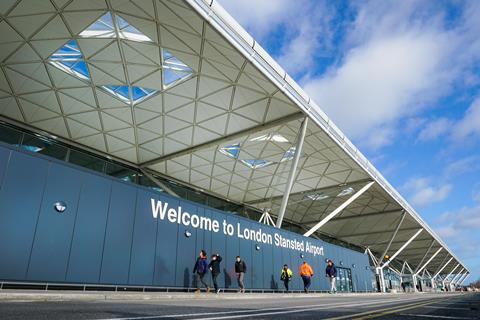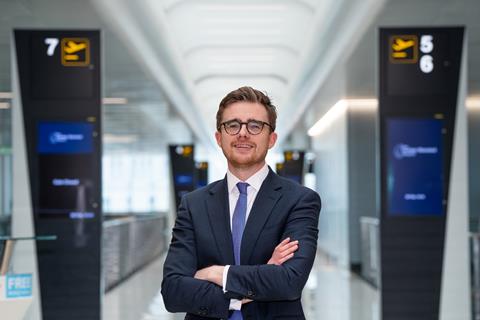London Stansted is famous as a low-cost gateway to Europe. However, while that legacy is important, the airport’s owners believe its potential goes much further
When its striking Norman Foster-designed terminal was unveiled in 1991, London Stansted became one of the most architecturally advanced and passenger-friendly airports in the world. Now – 11 years after its takeover by MAG – the capital’s third airport is preparing for the next phase of its development with its biggest investment spree in three decades to equip it for the 2030s and beyond.

As well as a significant investment to enhance the traveller experience and expand its capacity to 43 million passengers, Stansted is also looking to broaden its portfolio of airlines as well as its customer demographic. In particular, the airport intends tapping into one of the UK’s most dynamic economic clusters… which happens to be on its doorstep.
Stansted is known as a hub for low-cost and leisure carriers. It is Ryanair’s largest base and the likes of easyJet, Jet2, Pegasus and Sun Express operate to dozens of European destinations. However, while MAG’s aviation director Simon Gorrighan is proud of these relationships and the fact that Stansted offers more short-haul destinations than any other European airport, he states: “We have so much more to offer.”
The aspiration includes attracting more long-haul operators with the lure of a large contingent of regular leisure travellers already familiar with and loyal to the airport, as well as sizeable diaspora communities within a one-hour reach of Stansted. For that so-called VFR market who want to visit family or relatives further afield than Europe, their only current option is to make the longer journey to Heathrow or Gatwick.
However, an arguably larger prize for new airlines considering a move to Stansted is the burgeoning agri-tech, bioscience, and digital technologies sector based around the university city of Cambridge, just 30 minutes away. Some of its companies are among the fastest growing and successful in the UK and, believes Gorrighan, would lap up convenient business air connections from their local international airport.
Resurrecting transatlantic routes is a priority, after a gap of around 15 years. Destinations might include West Coast cities as well as Boston – many Cambridge firms have links with university spin-offs in the namesake Massachusetts metropolis, home to Harvard University and MIT. India and other parts of Asia – source of much of the talent pool for these high-tech businesses – is another part of the world where there is likely to be significant demand for direct services.
For now, Emirates is the only passenger widebody carrier operating from Stansted, with 14 services a week to Dubai on a Boeing 777. The flights – double what the airline was offering two years ago – have proved extremely popular because they offer a range of global connections beyond Dubai, including for premium travellers, according to Gorrighan. Emirates has just unveiled its first premium lounge at the airport, which has direct boarding to aircraft.
Stansted has had success with several mid-haul airlines, including Royal Jordanian, which operates four times a week to Amman. Turkey’s popularity as a holiday destination has also seen new services to that country. However, it has been the steady success of its mainstay airlines that has largely been behind the airport surpassing pre-Covid traffic with 28.5 million passengers in the year to March, up from 17.9 million when MAG took over from BAA.
Stansted’s appeal to new airlines is based around five Cs, says Gorrighan. These are its large catchment area and consequent competitiveness over rival airports in terms of filling aircraft; a customer experience that is set to get better; its capacity to offer slots and even base status to airlines; and its cost-effectiveness when it comes to airport charges.
Some 25 million people live or work within two hours of Stansted, and for millions – including in north-east London, Essex and East Anglia – Stansted is their nearest major airport. Accessibility is helped by excellent road and rail connections – trains for London Liverpool Street leave four times an hour from a station under the terminal and connect with the London underground system within 35 minutes.

Studies of load factors for city pairs available at other London airports show Stansted performs strongly in comparison, says Gorrighan. Meanwhile, a raft of improvements will create a bright, spacious environment with more seating areas, plus new shops, bars, and restaurants to give travellers even more choice than they have today.
When it comes to capacity, Stansted has a clear advantage over its slot-constrained competitors, including the ability for airlines to establish new bases. “We have permission to expand the airport to cope with 43 million passengers, and we are the first London airport to market base-aircraft capacity,” says Gorrighan.
The fifth C is cost-effectiveness. “Our charges are some of the most competitive in the London market,” he says. In terms of cargo, Stansted has two freight terminals. Turkish Airlines and Qatar Airways are among the blue-chip cargo specialists that use the resource, and there is space for more to join them, says Gorrighan.
MAG has no aspirations for Stansted to compete with Heathrow’s hub status. “We are point-to-point specialists,” insists Gorrighan. However, it does maintain that the airport has huge potential to add direct connections that are currently unserved from the UK and attract long-haul widebody airlines with a business class product.
“There is a perception Stansted has a low-cost traffic base and in many ways that is true,” says Gorrighan. “But we sit in a very wealthy catchment area, and we do believe there is an opportunity for a first mover to really capitalize on that.”










































